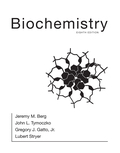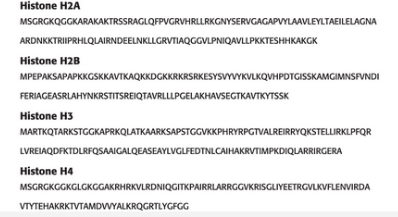
Interpretation:
The charge on histone octamer at pH 7 should be determined.
The charge on the histone should be compared with a charge on 150 bp DNA.
Concept introduction:
There are around 300 amino acids, but only 22 amino acids participate in protein synthesis. Such amino acids are termed as proteinogenic amino acids. Some amino acids are very common in protein chain, while some amino acids are rare in protein chain. The most abundant amino acids in the protein chain are leucine, serine, lysine, and glutamic acid.
Answer to Problem 1P
The charge on histone octamer at pH 7 is +146. The charge on 150 bp DNA strand is -300.
Explanation of Solution
Given information:
The histone octamer is at pH 7, and histidine neutralizes at this pH.

Histone H2A protein chain-
In histone H2A protein sequence, there are 4 charged amino acids, lysine, arginine, aspartic acid, and glutamic acid. Lysine amino acid has -NH3+ as the side chain, which ionizes at pH of 10.54. Therefore, at pH 7, this side chain of lysine will not neutralize, giving lysine residue +1 charge. There are 13 lysine residues, hence, charge on protein due to lysine is +13.
Arginine amino acid also has -NH3+ as the side chain, which ionizes at pH of 12.48. Therefore, at pH 7, this side chain of arginine will not neutralize, giving arginine residue +1 charge. There are 13 arginine residues, hence, charge on protein due to arginine is +13.
Aspartic acid has -COO- as side chain. This side chain ionizes when pH of the solution reaches to 3.86. At pH 7, -COO- will not accept the hydrogen ion, hence, the charge of aspartic acid will be -1. There are total 2 aspartate amino acids, therefore, the charge on protein due to this amino acid is -2.
Glutamic acid has -COO- as side chain. This side chain ionizes when pH of the solution reaches to 4.25. At pH 7, -COO- will not accept the hydrogen ion, hence, the charge of glutamic acid will be -1. There are total 7glutamate amino acids, therefore, the charge on protein due to this amino acid is -7.
Hence, total charge on H2A protein sequence = +13+13+ (-2) +(-7) = +17.
Histone H2B protein chain-
In histone H2B protein sequence, there are 4 charged amino acids, lysine, arginine, aspartic acid, and glutamic acid. Lysine amino acid has -NH3+ as the side chain, which ionizes at pH of 10.54. Therefore, at pH 7, this side chain of lysine will not neutralize, giving lysine residue +1 charge. There are 20 lysine residues, hence, charge on protein due to lysine is +20.
Arginine amino acid also has -NH3+ as the side chain, which ionizes at pH of 12.48. Therefore, at pH 7, this side chain of arginine will not neutralize, giving arginine residue +1 charge. There are 8 arginine residues, hence, charge on protein due to arginine is +8.
Aspartic acid has -COO- as side chain. This side chain ionizes when pH of the solution reaches to 3.86. At pH 7, -COO- will not accept the hydrogen ion, hence, the charge of aspartic acid will be -1. There are total 3 aspartate amino acids, therefore, the charge on protein due to this amino acid is -3.
Glutamic acid has -COO- as side chain. This side chain ionizes when pH of the solution reaches to 4.25. At pH 7, -COO- will not accept the hydrogen ion, hence, the charge of glutamic acid will be -1. There are total 7 glutamate amino acids, therefore, the charge on protein due to this amino acid is -7.
Hence, total charge on H2A protein sequence = +20+8+ (-3) +(-7) = +18.
Histone H3B protein chain-
In histone H3B protein sequence, there are 4 charged amino acids, lysine, arginine, aspartic acid, and glutamic acid. Lysine amino acid has -NH3+ as the side chain, which ionizes at pH of 10.54. Therefore, at pH 7, this side chain of lysine will not neutralize, giving lysine residue +1 charge. There are 13 lysine residues, hence, charge on protein due to lysine is +13.
Arginine amino acid also has -NH3+ as the side chain, which ionizes at pH of 12.48. Therefore, at pH 7, this side chain of arginine will not neutralize, giving arginine residue +1 charge. There are 18 arginine residues, hence, charge on protein due to arginine is +18.
Aspartic acid has -COO- as side chain. This side chain ionizes when pH of the solution reaches to 3.86. At pH 7, -COO- will not accept the hydrogen ion, hence, the charge of aspartic acid will be -1. There are total 4 aspartate amino acids, therefore, the charge on protein due to this amino acid is -4.
Glutamic acid has -COO- as side chain. This side chain ionizes when pH of the solution reaches to 4.25. At pH 7, -COO- will not accept the hydrogen ion, hence, the charge of glutamic acid will be -1. There are total 7 glutamate amino acids, therefore, the charge on protein due to this amino acid is -7.
Hence, total charge on H3A protein sequence = +13+18+ (-4) +(-7) = +20.
Histone H4B protein chain-
In histone H4B protein sequence, there are 4 charged amino acids, lysine, arginine, aspartic acid, and glutamic acid. Lysine amino acid has -NH3+ as the side chain, which ionizes at pH of 10.54. Therefore, at pH 7, this side chain of lysine will not neutralize, giving lysine residue +1 charge. There are 11 lysine residues, hence, charge on protein due to lysine is +11.
Arginine amino acid also has -NH3+ as the side chain, which ionizes at pH of 12.48. Therefore, at pH 7, this side chain of arginine will not neutralize, giving arginine residue +1 charge. There are 14 arginine residues, hence, charge on protein due to arginine is +14.
Aspartic acid has -COO- as side chain. This side chain ionizes when pH of the solution reaches to 3.86. At pH 7, -COO- will not accept the hydrogen ion, hence, the charge of aspartic acid will be -1. There are total 3 aspartate amino acids, therefore, the charge on protein due to this amino acid is -3.
Glutamic acid has -COO- as side chain. This side chain ionizes when pH of the solution reaches to 4.25. At pH 7, -COO- will not accept the hydrogen ion, hence, the charge of glutamic acid will be -1. There are total 4 glutamate amino acids, therefore, the charge on protein due to this amino acid is -4.
Hence, total charge on H4A protein sequence = +11+14+ (-3) +(-4) = +18.
There is a DNA with 150 bp.This means total number of bases in DNA strand are 300. Each base has -1 charge on it due to the presence of phosphate group. So, the total charge on DNA strand is -300. So, if this DNA strand binds around the above histone octamer, then half of the charges on DNA would get neutralized.
The charge on histone octamer at pH 7 is +146. The charge on 150 bp DNA strand is -300.
Want to see more full solutions like this?
- Activity: Write the line structure of each of the following peptide at pH7 and identify how many peptide bond in each number. 1 Alanyl-phenylalanine 2. Lysyl-alanine 3.Phenylalanyl-tyrosyl-leucinearrow_forwardStraight or with a twist? Account for the different structures of glycogen and cellulose.arrow_forwardActivity: Write the line structure of each of the following peptide at pH7 and identify how many peptide bond in each number. 1. Glycyl-valyl-serine 2. Threonyl-cysteine 3. Isoleucyl-methionyl-aspartatearrow_forward
- Fast please At 20 Celsius degree, protein-Z binds DNA with a free energy of –7 kJ/mole. Protein Z has an unfolding free energy of 11 kJ/mole without ligand bound and 15 kJ/mole with ligand bound. Does the unfolded/denatured form of protein Z bind to DNA, and if so – what is the "Delta G" of binding of the unfolded form?arrow_forwardMolecular detail of spike Y453Farrow_forwardPurification of a new unknown protein that you isolated from tissue and Assume that you have reached the following data during the characterization; Gel filtration: Gel filtration in protein native conformation When chromatographed, it has a molecular weight of 240000 daltons (240 kDa) is detected to be around. Gel filtration: The same protein is first denatured with 6 M guanidinium hydrochloride subjected to gel filtration chromatography again under denatured conditions. is retained, and the only column from the column with a molecular weight of about 60000 daltons (60 kDa) a protein is obtained. SDS-PAGE: Protein finally SDS-PAGE in the presence of beta-mercaptoethanol (Sodium dodecyl-sulphate polyacrylamide gel electrophoresis) analysis being held. As a result of SDS-PAGE analysis, their weight in the gel is approximately 40000 daltons. Two protein bands corresponding to (40 kDa) and 20000 daltons (20 kDa) is observed. In the light of these findings, the quaternary/quaternary…arrow_forward
- In α-helices - what is the length of the hydrogen bonds between: TYR41H and GLU37O ALA39H and MET35O GLU38H and ILE34O THR36H and ARG32O. ARG32H and TYR28Oarrow_forwardProtein folding with PDI and Peptidyl-prolyl isomerasearrow_forwardresting state of the protein, the Lys 216 Schiff base has pKa = 9.5 and Asp 85 has pKa = 3.5. When the conformational change occurs, the proton that was on the Schiff base moves to Asp 85. This should tell you that one or both of these two pKas changed with the conformational change. How does the pKa of Asp 85 compare with the pKa of the Lys 216 Schiff base after the conformational change?arrow_forward
- BIOMOLECULES - MULTIPLE CHOICE - Please answer properly QUESTION : In human beings, what is the major control of de novo pyrimidine nucleotide synthesis? A. substrate availability B. competitive inhibition of carbamoyl phosphate synthetase II C. feedback inhibition of glutamine-PRPP amidotransferase D. vailability of N-acetyl glutamatearrow_forwardRemember remove the introns! All introns start with GT and end with AG.arrow_forwardSerine protease enzyme mutation To show differences in the effect of the nucleophilic attack of the carbonyl group (C=O) of peptide bond between the catalytic triad of serine, histidine and aspartic acid, and another catalytic triad contains alanine, histidine and aspartic acid Provide/ draw an example of catalytic mechanism with catalytic triad contains alanine, histidine and aspartic Please answer completely will give rating surelyarrow_forward
 BiochemistryBiochemistryISBN:9781305577206Author:Reginald H. Garrett, Charles M. GrishamPublisher:Cengage Learning
BiochemistryBiochemistryISBN:9781305577206Author:Reginald H. Garrett, Charles M. GrishamPublisher:Cengage Learning Biology (MindTap Course List)BiologyISBN:9781337392938Author:Eldra Solomon, Charles Martin, Diana W. Martin, Linda R. BergPublisher:Cengage Learning
Biology (MindTap Course List)BiologyISBN:9781337392938Author:Eldra Solomon, Charles Martin, Diana W. Martin, Linda R. BergPublisher:Cengage Learning

